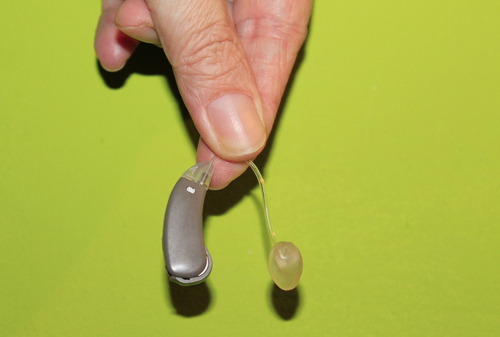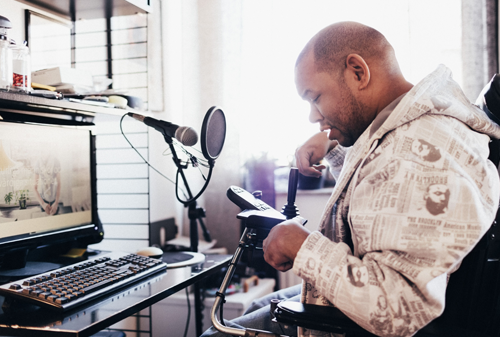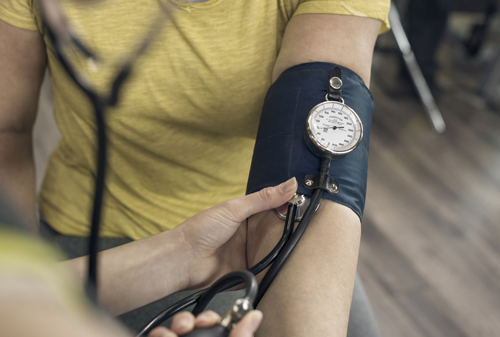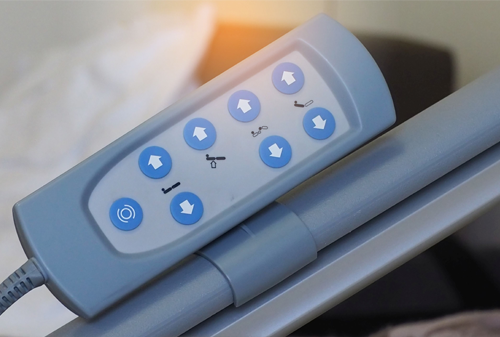




Technology is part of our modern landscape. We use it for work, leisure, at home and on the move. It makes our lives easier. Individuals with disabilities or age-related conditions should share that experience, benefitting from the advantages that tailor-made technological support can bring.
The term assistive technology (AT) refers to a broad range of devices (including software) and services intended to compensate for, or alleviate, an injury, disability or illness or to replace a physical function.
An Assistive Technology Device is defined as:
“any item, piece of equipment, or product system, whether acquired commercially, modified, or customized, that is used to increase, maintain, or improve functional capabilities of individuals with disabilities.”
Assistive Technology can help to support elderly people, people with disabilities, mental health problems and other vulnerable people to live as independently as possible in their own homes. Although originally focussed on the needs of older people it is now generally recognised as being of benefit across adult, carers and children’s services, and can play a key supporting role for people in everyday life.
The term electronic assistive technology can be used to describe an item, product, or system that is electronically powered (mains electricity and/or battery), often described as high-tech assistive technology, that fall within the definition of an assistive technology device.
Electronic assistive technology supports participation in a varied range of meaningful activities, supporting independence, learning and development, well-being, quality of life and access to services and information. Electronic assistive technology can be used in an individual’s environment, such as a hospital, their home, school, workplace or residential care facility.
For the users it:
Electronic assistive technology enables individuals to compensate for certain needs. This technology promotes independent living and decreases the need for other support. Electronic assistive technology can enable individuals to care for themselves and their families.
The concept of Electronic Assistive Technology is simple. Technology does what technology is good at – constant monitoring and automatic feedback. This frees staff to do what they are good at – the human touch.
Electronic Assistive Technology is not just about equipment; it is a complete service which includes providing an appropriate response. For service users, the benefit is increased reassurance, with less intrusion in their lives. The main benefit to social care services is that staff may be deployed more productively and in a more targeted way. It can give carers more personal freedom and more time to concentrate on the human aspects of care and support.
Example 1 - Typically, the individual may be housebound and living alone for all, or most of the time; they may or may not have close family living locally who can attend in the event of a problem. They need a 24/7 monitoring service to alert remote family members or care/emergency services as required.
Example 2 – The individual either lives with a family carer or has personal assistants who are with them at all times. There is no need for a monitoring service, as there is always a responder present.
Example 3 – This individual has close family support. Perhaps they live with a family carer who may be away from home sometimes. Any problems could be routed directly to the carer’s mobile phone in the first instance and only go to a monitoring service if the carer is unable to respond to the call.
Example 4 – This individual is generally well but would like a basic level of reassurance just in case; however, they are reluctant to involve external organisations. In this example, family members could use an activity monitoring service to monitor that everything is alright and set up alerts that they would receive on their mobile phone or computer if there was a problem (e.g. if mum hadn’t been to the kitchen to have a drink before 10am like she usually does).
Example 5 – This individual is mobile and is able to go out alone for work, shopping or leisure. Perhaps it is a young adult with a learning disability who has recently got a new job. Ideally, they need an ‘always-available’ approach that supports them when they are at home and out and about. Special apps for their smartphone could help them plan their day, find their way about and provide them with access to assistance if required.
Mae technoleg yn rhan o'n tirlun modern. Rydyn ni'n ei ddefnyddio ar gyfer gwaith, hamdden, gartref ac wrth symud. Mae'n gwneud ein bywydau yn haws. Dylai unigolion sydd ag anableddau neu gyflyrau sy'n gysylltiedig ag oedran rannu'r profiad hwnnw, gan elwa ar y manteision a all ddod yn sgil cymorth technolegol wedi'i deilwra.
Mae'r term technoleg gynorthwyol yn cyfeirio at ystod eang o ddyfeisiau (gan gynnwys meddalwedd) a gwasanaethau y bwriedir iddynt wneud iawn am neu leddfu anaf, anabledd neu salwch neu i gymryd lle swyddogaeth gorfforol.
Caiff Dyfais Technoleg Gynorthwyol ei diffinio fel:
"unrhyw eitem, darn o offer, neu system gynnyrch, p'un a gafodd ei chaffael yn fasnachol, ei newid, neu ei addasu, sy'n cael ei ddefnyddio i gynyddu, cynnal, neu wella galluoedd swyddogaethol unigolion sydd ag anableddau.”
Gall technoleg gynorthwyol helpu i gefnogi pobl oedrannus, pobl ag anableddau, pobl â phroblemau iechyd meddwl a phobl eraill sy'n agored i niwed i fyw mor annibynnol â phosibl yn eu cartrefi eu hunain. Er ei fod yn canolbwyntio'n wreiddiol ar anghenion pobl hŷn, fe'i cydnabyddir yn gyffredinol bellach fel un sydd o fudd ar draws gwasanaethau oedolion, gofalwyr a phlant, a gall chwarae rôl gefnogol allweddol i bobl mewn bywyd bob dydd.
Gellir defnyddio'r term technoleg gynorthwyol electronig i ddisgrifio eitem, cynnyrch, neu system sy'n cael ei bweru'n electronig (prif gyflenwad trydan a/neu fatri), a ddisgrifir yn aml fel technoleg gynorthwyol uwch-dechnoleg, sy'n dod o fewn y diffiniad o ddyfais technoleg gynorthwyol.
Mae technoleg gynorthwyol electronig yn cefnogi cyfranogiad mewn ystod amrywiol o weithgareddau ystyrlon, gan gefnogi annibyniaeth, dysgu a datblygiad, llesiant, ansawdd bywyd a mynediad at wasanaethau a gwybodaeth. Gellir defnyddio technoleg gynorthwyol electronig mewn amgylchedd unigolyn megis ysbyty, ei gartref, ysgol, gweithle neu gyfleuster gofal preswyl.
Ar gyfer y defnyddwyr mae'n:
Mae technoleg gynorthwyol electronig yn galluogi unigolion i wneud iawn am anghenion penodol. Mae'r dechnoleg hon yn hyrwyddo byw'n annibynnol ac yn lleihau'r angen am gymorth arall. Gall technoleg gynorthwyol electronig alluogi unigolion i ofalu amdanynt eu hunain a'u teuluoedd.
Mae'r cysyniad o Dechnoleg Gynorthwyol Electronig yn syml, mae technoleg yn gwneud yr hyn y mae technoleg yn dda am ei wneud; monitro cyson ac adborth awtomatig, gan ryddhau staff i wneud yr hyn y maent yn dda am ei wneud; y cyffyrddiad dynol.
Nid yw Technoleg Gynorthwyol Electronig yn ymwneud ag offer yn unig; Mae'n wasanaeth cyflawn sy'n cynnwys darparu ymateb priodol. I ddefnyddwyr gwasanaeth, y budd yw mwy o sicrwydd, gyda llai o ymyrraeth yn eu bywydau. Y brif fantais i wasanaethau gofal cymdeithasol yw y gall staff gael eu defnyddio'n fwy cynhyrchiol ac mewn ffordd fwy penodol. Gall roi mwy o ryddid personol i ofalwyr a mwy o amser iddynt ganolbwyntio ar yr agweddau dynol ar ofal a chymorth.
Enghraifft 1 - Yn nodweddiadol, gall yr unigolyn fod yn gaeth i'w cartref ac yn byw ar ei ben ei hun drwy'r amser, neu'r rhan fwyaf o'r amser; neu ni allant fod â theulu agos sy'n byw yn lleol a all fod yn bresennol os ceir problem. Mae angen gwasanaeth monitro 24/7 arnynt i rybuddio aelodau o'r teulu sy'n byw'n bell i ffwrdd neu wasanaethau gofal/argyfwng yn ôl y gofyn.
Enghraifft 2 – Mae'r unigolyn naill ai'n byw gyda gofalwr teuluol neu mae ganddo gynorthwywyr personol sydd gyda nhw drwy'r amser. Nid oes angen gwasanaeth monitro, gan fod ymatebwr yn bresennol bob amser.
Enghraifft 3 – Mae gan yr unigolyn hwn gefnogaeth deuluol agos. Efallai ei fod yn byw gyda gofalwr teuluol a all fod i ffwrdd o'i gartref weithiau. Gallai unrhyw broblemau gael eu cyfeirio'n uniongyrchol i ffôn symudol y gofalwr yn y lle cyntaf, a dim ond os nad yw'r gofalwr yn gallu ymateb i'r alwad y bydd yn mynd i wasanaeth monitro.
Enghraifft 4 – Mae'r unigolyn hwn yn dda yn gyffredinol ond hoffai gael lefel sylfaenol o sicrwydd rhag ofn; fodd bynnag, maent yn amharod i gynnwys sefydliadau allanol. Yn yr enghraifft hon, gallai aelodau'r teulu ddefnyddio gwasanaeth monitro gweithgareddau i fonitro bod popeth yn iawn ac i osod rhybuddion y byddent yn eu derbyn ar eu ffôn symudol neu gyfrifiadur pe bai problem (e.e. pe na bai mam wedi bod i'r gegin i gael diod cyn 10am yn ôl ei harfer).
Enghraifft 5 – Mae'r unigolyn hwn yn symudol ac mae'n gallu mynd allan ar ei ben ei hun ar gyfer gwaith, siopa neu hamdden. Efallai ei fod yn oedolyn ifanc ag anabledd dysgu sydd wedi cael swydd newydd yn ddiweddar. Yn ddelfrydol, mae angen agwedd 'ar gael bob amser' arnynt sy'n eu cefnogi pan fyddant gartref a phan fyddant allan. Gallai apiau arbennig ar gyfer eu ffôn clyfar eu helpu i gynllunio eu diwrnod, darganfod eu ffordd o gwmpas a'u galluogi i gael cymorth os oes angen.

All electronic assistive technology should meet the needs of the individual. Even if two people have the same condition or illness, they can have different degrees of impairment.
The focus has therefore shifted to a more personalised, person-centred approach.
This includes looking at the individual’s preferences, abilities, interest, goals, family and values in working out their care and support needs.
This means empowering the individual to improve their quality of life through a more preventive and collaborative approach which embraces their own strengths and assets. This, quite rightly, leads to higher expectations and personalised provision including the ability to take risks based on informed consent.
It also encourages the use of technology – especially as devices have become smaller, lighter, more reliable and more aesthetically pleasing.
Dylai pob technoleg gynorthwyol electronig ddiwallu anghenion yr unigolyn. Hyd yn oed os yw dau berson â'r un cyflwr neu salwch, gall fod ganddynt wahanol raddau o nam.
Felly, mae'r ffocws wedi symud i ddull mwy personol sy'n canolbwyntio ar yr unigolyn.
Mae hyn yn cynnwys edrych ar ddewisiadau, galluoedd, diddordebau, nodau, teulu a gwerthoedd yr unigolyn wrth ddatblygu ei anghenion gofal a chymorth.
Mae hyn yn golygu grymuso'r unigolyn i wella ei ansawdd bywyd drwy ddull mwy ataliol a chydweithredol sy'n ymgorffori ei gryfderau a'i asedau ei hun. Mae hyn, sy'n gwbl briodol, yn arwain at ddisgwyliadau uwch a darpariaeth wedi'i phersonoli gan gynnwys y gallu i gymryd risgiau ar sail cydsyniad gwybodus.
Mae hefyd yn annog y defnydd o dechnoleg – yn enwedig gan fod dyfeisiau wedi mynd yn llai, yn ysgafnach, yn fwy dibynadwy ac yn fwy deniadol yn esthetaidd.

Telecare and Telehealth are both types of Electronic Assistive Technology that enable health and social care services to provide ‘remote services’ to individuals in their own home or care setting. These two types of electronic assistive technology may also be used together to support the needs of an individual.
Telecare is defined as a device that allows automatic and remote monitoring to manage the risks associated with independent living. Examples include:
Telehealth is defined as the remote exchange of data between an individual and a health care professional and aims to assist in the diagnosis and management of health care conditions. Examples include:
Mae Teleofal a Theleiechyd yn fathau o dechnoleg gynorthwyol electronig sy'n galluogi gwasanaethau iechyd a gofal cymdeithasol i ddarparu 'gwasanaethau o bell' i unigolion yn eu cartref neu eu lleoliad gofal eu hunain. Gall y ddau fath hyn o dechnoleg gynorthwyol electronig hefyd gael eu defnyddio gyda'i gilydd i gefnogi anghenion unigolyn.
Diffinnir teleofal fel dyfais sy'n caniatáu monitro awtomatig ac o bell er mwyn rheoli'r risgiau sy'n gysylltiedig â byw'n annibynnol. Dyma rai enghreifftiau:
Diffinnir teleiechyd fel y ffordd o gyfnewid data o bell rhwng unigolyn a gweithiwr gofal iechyd proffesiynol a'i nod yw helpu i gael diagnosis a rheoli cyflyrau gofal iechyd. Dyma rai enghreifftiau:

In many cases, individuals with certain conditions would benefit from the use of electronic assistive devices, such as:
However, for a number of reasons they may be resistant to using this type of support. It will be the job of the health or social care worker to help the individual and their family of the benefits of this technology in enabling them to live a more normal life.
These benefits could include:
Mewn llawer o achosion, byddai unigolion â chyflyrau penodol yn elwa o ddefnyddio dyfeisiau cynorthwyol electronig, megis:
Fodd bynnag, am nifer o resymau, gallant fod yn wrthwynebus i ddefnyddio'r math hwn o gymorth. Gwaith y gweithiwr iechyd neu ofal cymdeithasol fydd helpu'r unigolyn a'i deulu i fanteisio ar y dechnoleg hon i'w galluogi i fyw bywyd mwy normal.
Gallai’r manteision hyn gynnwys y canlynol:

It is usual that complex disability needs assessments are undertaken by multi-disciplinary teams involving professionals and specialists across relevant fields, including local therapists and carers. This enables the widest knowledge and experience base to be utilised, helping to improve provision, maximising the potential benefits to the assistive technology user.
The professionals who have a particular role or expertise in using electronic assistive technology are:
Occupational Therapist (OT) - The role of an OT involves the evaluation of body movement and physical capabilities including fine motor and gross motor skills, touch and sensory perception, posture and positioning, and analysis of the environment, user needs, and access methods when considering provision of assistive technology. They are experts in:
Speech and Language Therapist (SALT) - The role of a SALT is to evaluate disabilities affecting speech and language, including swallowing disorders. This will involve assessing the individual’s communication abilities and needs, in order to identify suitable Augmentative and Alternative Communication (AAC) options with appropriate vocabulary.
Physiotherapists - Physiotherapists help treat and manage physical problems to restore movement and function, adopting a holistic approach to disability and rehabilitation. They may work in a number of areas such as neurology (including stroke), long-term conditions, and care for the elderly, looking at movement and exercise as well as manual therapy to improve function. Working as part of a multidisciplinary team they may work closely with OT’s to evaluate seating, positioning and mobility, and to look at an individual’s posture and movement to find the best position, or adaptation, for optimal access to assistive technology.
Healthcare Scientists (HCS) working within the NHS - The term Healthcare Scientist is used by the NHS to cover a broad staff grouping of scientists, engineers, and technologists. The title is intended to encompass the area of scientific related jobs rather than implying that all people within this grouping are actual scientists, although some are.
Education and Teaching Professionals - Education professionals have important roles in both multidisciplinary teams during an assessment and within the educational setting. Assessments require a good understanding of a student’s characteristics and capabilities in relation to education and technology in accessing the curriculum and academic performance. The education professional (e.g. SEN Teacher) should also have the knowledge, skills and competencies to support students with the use of assistive technology in an educational setting.
Fel arfer, cynhelir asesiadau cymhleth o anghenion anabledd gan dimau amlddisgyblaethol sy'n cynnwys gweithwyr proffesiynol ac arbenigwyr ar draws meysydd perthnasol, gan gynnwys therapyddion a gofalwyr lleol. Mae hyn yn galluogi'r sylfaen wybodaeth a phrofiad ehangaf i gael ei defnyddio, gan helpu i wella'r ddarpariaeth, gan fanteisio i'r eithaf ar y buddiannau posibl i'r defnyddiwr technoleg gynorthwyol.
Y gweithwyr proffesiynol sydd â rôl neu arbenigedd penodol mewn technoleg gynorthwyol electronig yw'r canlynol:
Therapydd galwedigaethol - Mae swyddogaeth therapydd galwedigaethol yn golygu gwerthuso symudiad y corff a galluoedd corfforol gan gynnwys sgiliau echddygol manwl a bras, cyffyrddiad a chanfyddiad synhwyraidd, ystum a lleoliad, a dadansoddi'r amgylchedd, anghenion y defnyddiwr, a dulliau mynediad wrth ystyried darparu technoleg gynorthwyol. Maent yn arbenigwyr mewn:
Therapydd Iaith a Lleferydd - Rôl therapydd iaith a lleferydd yw gwerthuso anableddau sy'n effeithio ar leferydd ac iaith, gan gynnwys anhwylderau llyncu. Bydd hyn yn cynnwys asesu gallu ac anghenion cyfathrebu'r unigolyn, er mwyn nodi dewisiadau cyfathrebu mwyhaol ac amgen addas gyda geirfa briodol.
Ffisiotherapyddion - Mae ffisiotherapyddion yn helpu i drin a rheoli problemau corfforol er mwyn adfer symudiad a swyddogaeth, gan fabwysiadu ymagwedd gyfannol at anabledd ac adsefydlu. Gallant weithio mewn nifer o feysydd megis niwroleg (gan gynnwys strôc), cyflyrau hirdymor, a gofal am yr henoed, edrych ar symud ac ymarfer corff yn ogystal â therapi â llaw i wella swyddogaeth. Gan weithio fel rhan o dîm amlddisgyblaethol, efallai y byddant yn gweithio'n agos gyda therapyddion galwedigaethol i werthuso seddau, lleoliad, a symudedd ac i edrych ar osgo corff a symudedd unigolyn i ddod o hyd i'r safle, neu'r addasiad, gorau ar gyfer mynediad gorau i dechnoleg gynorthwyol.
Gwyddonwyr Gofal Iechyd sy'n gweithio yn y GIG - Mae'r term Gwyddonydd Gofal Iechyd yn cael ei ddefnyddio gan y GIG i gwmpasu grŵp staff eang o wyddonwyr, peirianwyr a thechnolegwyr. Bwriedir i'r teitl gwmpasu'r maes o swyddi sy'n gysylltiedig â gwyddoniaeth yn hytrach nag awgrymu bod pawb yn y grŵp hwn yn wyddonwyr go iawn, er bod hyn yn wir am rai ohonynt.
Gweithwyr Proffesiynol Addysg ac Addysgu - Mae gan weithwyr addysg proffesiynol rôl bwysig yn y ddau dîm amlddisgyblaethol yn ystod asesiad ac yn y lleoliad addysgol. Mae asesiadau yn gofyn am ddealltwriaeth dda o nodweddion a galluoedd myfyriwr mewn perthynas ag addysg a thechnoleg wrth gyrchu'r cwricwlwm a pherfformiad academaidd. Dylai'r gweithiwr addysg proffesiynol (e.e. Athro AAA) hefyd fod â'r wybodaeth, y sgiliau a'r cymwyseddau i gefnogi myfyrwyr gyda'r defnydd o dechnoleg gynorthwyol mewn lleoliad addysgol.

Assistive Technology can not only help individuals live more independently, but it may also make a care worker's job easier and more enjoyable. A committed care worker is vital throughout the technology implementation process and any assistive technology should support the care workers and not replace them.
Care workers need to be trained in how to care for an individual and how the assistive technology is integrated into the care process.
The individual, along with their care workers and a team of professionals and consultants (e.g social worker, occupational therapists), usually decide which type of rehabilitative or assistive technology would be most helpful.
The team is trained to match assistive technologies to specific needs to help the individual function more independently.
The individual may need to be motivated to use assistive technology and to understand how they can benefit from it before they are willing to accept and start to its use. Research has shown that some individual’s may stop using their assistive technology for many reasons including:
Therefore, the caregiver's role is vital in supporting the individual to use the assistive technology recommended. They should also be able to support others to facilitate the use of assistive technology by providing information to others about assistive technology and guidance in the use of assistive technology in line with agreed ways of working. They should:
The area of assistive technology has developed in recent years, and there is a wide range of products and devices. It can be confusing, however, to determine which products might be right for an individual.
Focus on the actual tasks the individual wants or needs to do when choosing devices. It’s easy to get drawn into using a product that looks good but doesn’t really address the individual’s needs. It is best to choose the simplest product available to meet their need. Simpler devices are often easier to use, less expensive, and easier to repair and maintain than more complex devices.
Talk to the experts that provide care to the individual, such as rehabilitation specialists, physio and occupational therapists, or adult day care staff, about which type of technology might be best. Ask to use the device on a trial basis to see if it is truly going to meet the individual’s needs.
The individual’s opinion about a certain piece of AT is the most important. The device needs to meet their needs and be comfortable and simple to use.
Additional support may be required to:
Gall technoleg gynorthwyol nid yn unig helpu unigolion i fyw'n fwy annibynnol, ond gall hefyd wneud swydd gweithiwr gofal yn haws ac yn fwy pleserus. Mae gweithiwr gofal ymroddedig yn hanfodol drwy gydol y broses o weithredu technoleg a dylai unrhyw dechnoleg gynorthwyol gefnogi'r gweithwyr gofal a pheidio â chymryd eu lle.
Mae angen i weithwyr gofal gael eu hyfforddi ar sut i ofalu am unigolyn a sut y caiff y dechnoleg gynorthwyol ei hintegreiddio yn y broses ofal.
Mae'r unigolyn, ynghyd â'i weithwyr gofal a thîm o weithwyr proffesiynol ac ymgynghorwyr (e.e. gweithiwr cymdeithasol, therapyddion galwedigaethol), fel arfer yn penderfynu pa fath o dechnoleg adsefydlu neu gynorthwyol fyddai fwyaf defnyddiol.
Mae'r tîm wedi'i hyfforddi i baru technolegau cynorthwyol ag anghenion penodol er mwyn helpu'r unigolyn i weithio'n fwy annibynnol.
Efallai y bydd angen cymell yr unigolyn i ddefnyddio technoleg gynorthwyol ac i ddeall sut y gall elwa arno cyn y bydd yn barod i dderbyn a dechrau ei ddefnyddio. Mae ymchwil wedi dangos y gall rhai unigolion roi'r gorau i ddefnyddio eu technoleg gynorthwyol am sawl rheswm, gan gynnwys:
Felly, mae rôl y rhoddwr gofal yn hanfodol o ran cynorthwyo'r unigolyn i ddefnyddio'r dechnoleg gynorthwyol a argymhellir. Dylent hefyd allu cefnogi eraill i hwyluso'r defnydd o dechnoleg gynorthwyol drwy ddarparu gwybodaeth i eraill am dechnoleg gynorthwyol a chanllawiau ar y defnydd o dechnoleg gynorthwyol yn unol â ffyrdd o weithio y cytunwyd arnynt. Dylent:
Mae'r maes technoleg gynorthwyol wedi datblygu dros y blynyddoedd diwethaf, ac mae ystod eang o gynnyrch a dyfeisiau. Fodd bynnag, gall fod yn ddryslyd penderfynu pa gynhyrchion allai fod yn iawn i unigolyn.
Canolbwyntio ar y tasgau y mae'r unigolyn eisiau neu angen eu gwneud wrth ddewis dyfeisiau. Mae'n hawdd cael eich tynnu i mewn i ddefnyddio cynnyrch sy'n edrych yn dda ond nad yw'n mynd i'r afael ag anghenion yr unigolyn mewn gwirionedd. Mae'n well dewis y cynnyrch symlaf sydd ar gael i ddiwallu eu hangen. Mae dyfeisiadau symlach yn aml yn haws eu defnyddio, yn rhatach, ac yn haws i'w trwsio a'u cynnal na dyfeisiau mwy cymhleth.
Siarad â'r arbenigwyr sy'n darparu gofal i'r unigolyn, fel arbenigwyr adsefydlu, ffisiotherapyddion a therapyddion galwedigaethol, neu staff gofal dydd i oedolion, ynghylch pa fath o dechnoleg fyddai orau. Gofynnwch am gael defnyddio'r ddyfais ar sail prawf i weld a yw'n mynd i ddiwallu anghenion yr unigolyn mewn gwirionedd.
Barn yr unigolyn am ddarn penodol o Dechnoleg Gynorthwyol yw'r pwysicaf. Mae angen i'r ddyfais fod yn gyfforddus, yn syml i'w defnyddio a diwallu ei angen.
Efallai y bydd angen cymorth ychwanegol er mwyn:

Both the individual and the care worker can carry out checks on the technology to limit the event of a failure/breakdown of equipment. This could include:
All electronic assistive technology will be supported by a technical team and the equipment should be serviced annually.
It is vital that in the event of the electronic assistive technology failing, the following steps are followed:
Gall yr unigolyn a'r gweithiwr gofal wirio'r dechnoleg i gyfyngu ar y digwyddiad o gyfarpar yn methu/torri i lawr. Gallai hyn gynnwys:
Bydd pob technoleg gynorthwyol electronig yn cael ei chefnogi gan dîm technegol a dylai'r offer dderbyn gwasanaeth yn flynyddol.
Os bydd y dechnoleg gynorthwyol electronig yn methu, mae'n hanfodol bod y camau canlynol yn cael eu dilyn:
Local Authorities' social services teams are responsible for assessing individual's needs and deciding whether they require electronic assistive technology.
If an individual, family member or G.P. thinks that they need electronic assistive technology to help them manage more safely and easily around their home, they can make a referral to the social services department of their local authority and ask for a care needs assessment.
Social Services will generally arrange for the individual to have an assessment and their need for an electronic assistive device will be identified. The assessment must take into account all aspects of the individual’s needs and the assessment will decide on the provision of electronic assistive technology.
The provision of electronic assistive technology will be reviewed regularly both to confirm that the devices are working properly and to identify changing needs. If an individual’s conditions and needs change over time, they will need to be referred to social services to have their needs assessed again.
This helps the individual to have the right amount of care in place to allow them as much independence as possible and ensures that they don't become too dependent on the electronic assistive technology.
Timau gwasanaethau cymdeithasol awdurdodau lleol sy'n gyfrifol am asesu anghenion unigolion a phenderfynu a oes angen technoleg gynorthwyol electronig arnynt.
Os yw unigolyn, aelod o deulu neu feddyg teulu yn credu bod angen technoleg gynorthwyol electronig arnynt i'w helpu i ymdopi o gwmpas eu cartref yn haws ac yn fwy diogel, gallant wneud atgyfeiriad i adran gwasanaethau cymdeithasol eu hawdurdod lleol a gofyn am asesiad anghenion gofal.
Yn gyffredinol bydd y Gwasanaethau Cymdeithasol yn trefnu i’r unigolyn gael asesiad a chaiff ei angen am ddyfais gynorthwyol electronig ei nodi. Rhaid i'r asesiad ystyried pob agwedd ar anghenion yr unigolyn a bydd yr asesiad yn penderfynu ar y ddarpariaeth o dechnoleg gynorthwyol electronig.
Bydd y ddarpariaeth o dechnoleg gynorthwyol electronig yn cael ei hadolygu'n rheolaidd i gadarnhau bod y dyfeisiau'n gweithio'n iawn ac i nodi anghenion sy'n newid. Os bydd amodau ac anghenion unigolyn yn newid dros amser, bydd angen ei atgyfeirio i'r gwasanaethau cymdeithasol er mwyn i'w anghenion gael eu hasesu eto.
Mae hyn yn helpu'r unigolyn i gael cyfran cywir o ofal yn ei le er mwyn rhoi cymaint o annibyniaeth ag sy'n bosibl iddo a sicrhau nad yw'n mynd yn rhy ddibynnol ar y dechnoleg gynorthwyol electronig.

Electronic assistive technology is an ongoing process for getting the best out of the technology. Some individuals may struggle to understand and engage with the technology in their homes. It is important that the care worker is there to support and motivate the individual to use the technology.
This may include greater knowledge of the technology and how it meets the individual’s needs. A risk assessment may also be required to ensure that both the individual and care worker understand how to use the technology safely.
It is essential that the user and care worker are present when installing the technology as training will be provided on how to use it safely. They should both ensure that the instruction book is followed to ensure the safe use of the technology.
It is vital that both the individual and care worker have a clear understanding of how to:
Some devices may be linked to the internet and social media, and both the individual and care worker need to be aware of security measures in place to ensure safety for both. Information security must be built into any assistive technology to ensure confidentiality (privacy), data integrity, availability and accountability. In particular personal information must be stored securely, and devices for accessing this information must be secured against unauthorised access to information.
There are Health and Safety legislations and government policies that support the safe use of electronic assistive technology and in meeting the individual's needs.
There are also regulatory bodies and care setting procedures that will also support the individual and the use of electronic assistive technology.
Mae technoleg gynorthwyol electronig yn broses barhaus ar gyfer cael y gorau o'r dechnoleg. Efallai y bydd rhai unigolion yn ei chael yn anodd deall ac ymgysylltu â'r dechnoleg yn eu cartrefi. Mae'n bwysig bod y gweithiwr gofal yno i gefnogi a chymell yr unigolyn i ddefnyddio'r dechnoleg.
Gall hyn gynnwys mwy o wybodaeth am y dechnoleg a sut mae'n diwallu anghenion yr unigolyn. Efallai y bydd angen asesiad risg hefyd i sicrhau bod yr unigolyn a'r gweithiwr gofal yn deall sut i ddefnyddio'r dechnoleg yn ddiogel.
Mae'n hanfodol bod y defnyddiwr a'r gweithiwr gofal yn bresennol wrth osod y dechnoleg gan y bydd hyfforddiant yn cael ei ddarparu ar sut i'w ddefnyddio'n ddiogel. Dylent sicrhau bod y llyfr cyfarwyddyd yn cael ei ddilyn er mwyn sicrhau bod y dechnoleg yn cael ei defnyddio'n ddiogel.
Mae'n hanfodol bod gan yr unigolyn a'r gweithiwr gofal ddealltwriaeth glir o sut i wneud y canlynol:
Gall rhai dyfeisiau fod yn gysylltiedig â'r rhyngrwyd a chyfryngau cymdeithasol, ac mae angen i'r unigolyn a'r gweithiwr gofal fod yn ymwybodol o'r mesurau diogelwch sydd ar waith i sicrhau diogelwch ar gyfer y ddau. Rhaid cynnwys diogeledd gwybodaeth mewn unrhyw dechnoleg gynorthwyol er mwyn sicrhau cyfrinachedd (preifatrwydd), cyfanrwydd data, argaeledd ac atebolrwydd. Yn arbennig, rhaid i wybodaeth bersonol gael ei storio'n ddiogel, a rhaid i ddyfeisiau ar gyfer cael gafael ar y wybodaeth hon gael eu diogelu rhag mynediad heb awdurdod i wybodaeth.
Mae deddfwriaethau Iechyd a Diogelwch a pholisïau'r llywodraeth sy'n cefnogi'r defnydd diogel o dechnoleg gynorthwyol electronig ac yn diwallu anghenion yr unigolyn.
Mae yna hefyd gyrff rheoleiddio a gweithdrefnau gosod gofal a fydd hefyd yn cefnogi'r unigolyn a'r defnydd o dechnoleg gynorthwyol electronig.
When making informed choices about the use of electronic assistive technology it is important to use a co-productive approach. The inclusion of the individual when choosing the correct equipment is vital in getting them to accept the use of the technology in meeting their required needs.
Individuals and their family should have an input into the expectation of use and should be encouraged to explore the potential use of the equipment from the outset. The electronic assistive technology and its purpose and benefits should be explained.
Both the individual and their family should be educated about the technology, ensuring that the individual knows why you are recommending the device, how to use it and what to do if there are any problems. This will also help the family, so they can promote the use of the electronic assistive technology also.
By working co-productively, it will help to support an individual and others in understanding the benefits of electronic assistive technology and how it will support their dignity, independence and privacy. It will also assist in addressing any conflicts between the proposed electronic assistive technology the individual’s rights.
Wrth wneud dewisiadau gwybodus am y defnydd o dechnoleg gynorthwyol electronig mae'n bwysig defnyddio dull cyd-gynhyrchiol. Mae cynnwys yr unigolyn wrth ddewis yr offer cywir yn hanfodol er mwyn eu cael i dderbyn y defnydd o'r dechnoleg i ddiwallu eu hanghenion gofynnol.
Dylai unigolion a'u teuluoedd gael mewnbwn i'r disgwyliadau o ran defnydd a dylid eu hannog i archwilio'r defnydd posibl o'r offer o'r cychwyn cyntaf. Dylid esbonio'r dechnoleg gynorthwyol electronig a'i bwrpas a'i fanteision.
Dylai'r unigolyn a'i deulu gael eu haddysgu am y dechnoleg, gan sicrhau bod yr unigolyn yn gwybod pam eich bod yn argymell y ddyfais, sut i'w defnyddio a beth i'w wneud os oes unrhyw broblemau. Bydd hyn hefyd yn helpu'r teulu, fel y gallant hyrwyddo'r defnydd o'r dechnoleg gynorthwyol electronig hefyd.
Drwy weithio mewn ffordd gydgynhyrchiol, bydd yn helpu i gefnogi unigolyn ac eraill i ddeall manteision technoleg gynorthwyol electronig a sut y bydd yn cefnogi eu hurddas, eu hannibyniaeth a'u preifatrwydd. Bydd hefyd yn helpu i fynd i'r afael ag unrhyw wrthdaro rhwng y dechnoleg gynorthwyol electronig arfaethedig a hawliau'r unigolyn.

Being able to support others in the use of electronic assistive technology will help to achieve positive outcomes.
One way to do this is to find out the role of other organisations and services that currently use electronic assistive technology and assess the availability of support for the individual and their family.
It is essential to contribute to the implementation of electronic assistive technology and utilise all expertise in supporting individuals, their families and carers.
Achieving positive outcomes by obtaining feedback from individuals and others to support the use of electronic assistive technology will also assist in positive outcomes.
All people involved in the use of electronic assistive technology should be able to promote and positively support its use.
Gathering information and feedback on the impact of the technology from the people involved in its use and sharing that information will help with the outcomes for other individuals, families and caregivers.
Caregivers should follow policies and procedures or agreed ways of working, in relation to electronic assistive technology when working in an individual’s own home or care setting. They should also follow risk assessment guidelines and reporting and recording procedures.
The individual’s family and caregivers need to be aware of the procedures relating to the use of electronic assistive technology, particularly to security and personal safety.
Bydd gallu cefnogi eraill i ddefnyddio technoleg gynorthwyol electronig yn helpu i sicrhau canlyniadau cadarnhaol.
Un ffordd o wneud hyn yw cael gwybod beth yw rôl sefydliadau a gwasanaethau eraill sy'n defnyddio technoleg gynorthwyol electronig ar hyn o bryd, ac asesu faint o gymorth sydd ar gael i'r unigolyn a'i deulu.
Mae'n hanfodol cyfrannu at y gwaith o roi technoleg gynorthwyol electronig ar waith a defnyddio pob arbenigedd wrth gefnogi unigolion, eu teuluoedd a'u gofalwyr.
Bydd cyflawni canlyniadau cadarnhaol drwy gael adborth gan unigolion ac eraill i gefnogi'r defnydd o dechnoleg gynorthwyol electronig hefyd yn helpu i sicrhau canlyniadau cadarnhaol.
Dylai pawb sy'n ymwneud â defnyddio technoleg gynorthwyol electronig allu hyrwyddo'r defnydd ohono a'i gefnogi'n gadarnhaol.
Bydd casglu gwybodaeth ac adborth ar effaith y dechnoleg gan y bobl sy'n ei defnyddio a rhannu'r wybodaeth honno yn helpu gyda'r canlyniadau i unigolion, teuluoedd a rhoddwyr gofal eraill.
Dylai gofalwyr ddilyn polisïau a gweithdrefnau neu ffyrdd o weithio y cytunwyd arnynt, mewn perthynas â thechnoleg gynorthwyol electronig wrth weithio yng nghartref neu leoliad gofal unigolyn. Dylent hefyd ddilyn canllawiau asesu risg a gweithdrefnau adrodd a chofnodi.
Mae angen i deulu a gofalwyr yr unigolyn fod yn ymwybodol o'r gweithdrefnau sy'n ymwneud â defnyddio technoleg gynorthwyol electronig, yn enwedig o ran diogelwch a diogelwch personol.

Under the Social Services and Wellbeing (Wales) Act, there are new formal responsibilities for local authorities to provide care and support for those older and disabled people who meet their eligibility criteria, to prevent deterioration and reduce demands on other services. Meeting these needs includes adaptations to the home and provision of electronic assistive technologies.
Risk Assessment - Ensuring that a risk assessment is carried out prior the electronic assistive technology is introduced will assist in the safe use of technology. The risk assessment should include all individuals that will be using the technology.
Training - It is essential that the individual, family members and caregivers are trained in how to use the electronic assistive technology correctly. In doing so, there will be a lower safety risk to the individual.
Maintenance - Both the individual and the care worker can carry out checks on the technology to limit the event of a failure of the equipment. This could include physical checks of equipment before use, reading and following the manufacturer’s instruction manual, scheduling regularly maintenance checks and having an annual service.
Age Cymru - May be able to offer general assistance, support and advice in regard to community care, paying for services and dealing with a local authority or other organisations. You can also ask them for a full benefit check to help maximise your income.
Disabled Living Foundation (DLF) - The DLF provides information about equipment for daily living and specialist advice on clothing, including ways of raising funds to purchase equipment.
Care and Repair Cymru - They work to ensure that older people living in owner occupied or private rented housing have homes that are safe, secure and appropriate to their needs.
British Red Cross - Offers services, such as equipment and wheelchair loans, domiciliary care, home from hospital support and transport services.
O dan Ddeddf Gwasanaethau Cymdeithasol a Llesiant (Cymru), mae cyfrifoldeb ffurfiol newydd ar awdurdodau lleol i ddarparu gofal a chymorth i'r bobl hŷn ac anabl hynny sy'n bodloni eu meini prawf cymhwyster, i atal dirywiad ac i leihau'r galwadau ar wasanaethau eraill. Mae diwallu'r anghenion hyn yn cynnwys addasu'r cartref a darparu technolegau cynorthwyol electronig.
Asesu Risg - Bydd sicrhau bod asesiad risg yn cael ei wneud cyn cyflwyno'r dechnoleg gynorthwyol electronig yn helpu i ddefnyddio technoleg yn ddiogel. Dylai'r asesiad risg gynnwys pob unigolyn a fydd yn defnyddio'r dechnoleg.
Hyfforddiant - Mae'n hanfodol bod yr unigolyn, aelodau'r teulu a'r gofalwyr yn cael eu hyfforddi i ddefnyddio'r dechnoleg gynorthwyol electronig yn gywir. Wrth wneud hynny, bydd llai o risg i'r unigolyn o ran diogelwch.
Cynnal a chadw - Gall yr unigolyn a'r gweithiwr gofal archwilio'r dechnoleg i leihau'r achosion o gyfarpar yn methu. Gallai hyn gynnwys gwiriadau corffol o offer cyn ei ddefnyddio, darllen a dilyn llawlyfr cyfarwyddiadau'r gwneuthurwr, trefnu gwiriadau cynnal a chadw rheolaidd a chael gwasanaeth blynyddol.
Age Cymru - Efallai y gall Age Cymru gynnig cymorth, cefnogaeth a chyngor cyffredinol o ran gofal yn y gymuned, talu am wasanaethau a delio ag awdurdod lleol neu sefydliadau eraill. Gallwch hefyd ofyn iddynt am wiriad budd-daliadau llawn i helpu i gynyddu eich incwm.
Disabled Living Foundation (DLF) - Mae'r DLF yn darparu gwybodaeth am offer ar gyfer bywyd bob dydd a chyngor arbenigol ar ddillad, gan gynnwys ffyrdd o godi arian i brynu offer.
Care and Repair Cymru - Maent yn gweithio er mwyn sicrhau bod gan bobl hŷn sy'n byw mewn tai preswyl neu dai rhent preifat gartrefi sy'n ddiogel ac yn briodol i'w hanghenion.
Y Groes Goch Brydeinig - Yn cynnig gwasanaethau, megis offer a benthyciadau cadeiriau olwyn, gofal yn y cartref, cymorth yn y cartref o'r ysbyty a gwasanaethau trafnidiaeth.